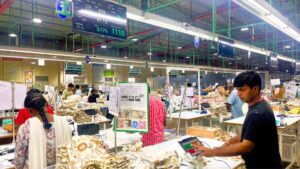In addition to expressing pleasure with the work being done in the textile sector, Prime Minister Narendra Modi has stated that he is confident India will surpass the 2030 aim and reach the ₹9 lakh crore annual export target.
The declaration of a five-year Cotton Mission to boost cotton productivity, particularly for extra-long staple types, in the General Budget 2025 makes this significant. The National Cotton Technology Mission was allocated approximately US $ 60 million.
Modi stated at the Bharat Tex 2025 that India is currently the world’s sixth-largest exporter of clothing and textiles, with exports worth about US $ 36 billion. Going forward, we want to triple this amount and reach US $ 108 billion in exports.
While the global market for recycled textiles is expected to reach US $ 7.5 billion, he predicted that India’s textile recycling sector might reach US $ 400 million in the next years. According to him, India might increase its market share if it were to go in the correct route.
He also opined that the nation’s exports of clothing and textiles have grown at a rate of 7 per cent. He credited this success to the diligent efforts and steady policies put in place over the previous ten years, which have doubled foreign investment in the textile industry during that time.
Regarding the Mission for Cotton Productivity, which was announced in the Budget, he stated that it will improve the value chain, make Indian cotton globally competitive, and make the cotton supply reliable.
According to him, India is making progress in producing high-quality carbon fibre.
Additionally, Modi encouraged officials of the banking sector to comprehend the priorities and needs of the textile industry and to support it.
Along with urging the textile industry to work with reputable institutions like IITs to create new tools, Modi also mentioned that the necessary policy measures were being made to promote the textile industry. He used the Budget’s announcement of MSME-related provisions as an example.
He emphasised the marketing campaigns aimed at promoting the handloom industry and its genuineness. More than 2,400 marketing events have been planned to promote handlooms in the last ten years.
According to him, the geographical indication (GI) branding of handloom items is greatly helping these brands.
He noted that the use of artificial intelligence in trend forecasting is growing, underscoring the significance of technology in identifying new trends and developing new styles. He emphasised how modern technology are now being used to improve India’s traditional sustainable methods, which benefits weavers, artisans, and the millions of women who work in the sector.
According to Modi, the textile ministry and the Standing Conference of Public Enterprises and e-Marketplace have inked a Memorandum of Understanding to encourage upcycling, and many upcyclers have already registered.
In locations like Bengaluru and Navi Mumbai, pilot schemes for the door-to-door collecting of textile waste are operating.







